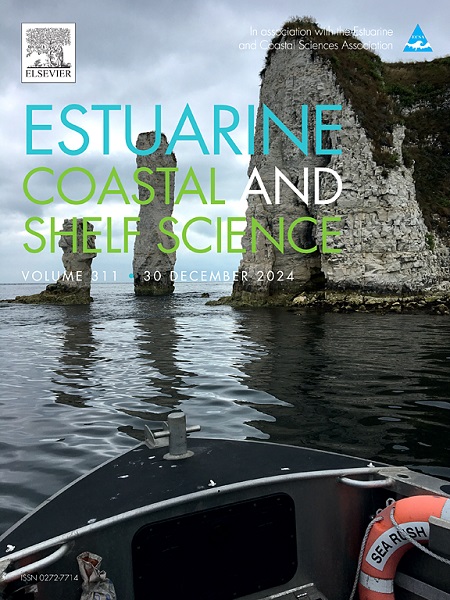元社会-生态系统中的沙滩:生态、管理和保护的综合框架
IF 2.6
3区 地球科学
Q1 MARINE & FRESHWATER BIOLOGY
引用次数: 0
摘要
沙滩是嵌入在更广泛的元社会生态系统(M-SES)中的动态生态系统,由跨生态系统流动、营养连通性和多尺度人类压力形成。在这里,我们开发了一个综合的M-SES框架,以促进对沙滩的理解、管理和保护,将其作为更广泛的元生态网络中相互关联的节点。我们综合了元种群结构、元群落动态和元生态系统过程的关键模式,强调了沙滩在维持区域生物多样性、能量通量和生态系统功能方面的关键作用。虽然由沙丘、海滩和冲浪带组成的沿海活动带(LAZ)之间的相互联系支撑着当地的生态系统功能,但元生态系统过程是由LAZ与邻近系统(如河口、珊瑚礁、近岸远洋带)之间的交换产生的。这些连接越来越多地被本地和跨领域的压力源破坏。我们引入了元沉积物的概念,将沙滩作为海洋和大气过程中污染物的动态汇和再分配中心。本地压力源(如践踏、采砂)和跨领域压力(如沿海挤压、塑料污染、气候变化)与治理缺陷相互作用,加剧生态系统退化,破坏生物多样性、生态系统服务和沿海复原力。M-SES框架通过将生态连通性与制度和社会维度相结合,促进了多尺度、适应性治理。关键战略包括加强多中心治理,促进基于自然的解决方案,通过参与机制增强韧性,并酌情将跨领域连通性纳入空间规划。环境DNA、遥感和社会生态模型等新兴工具为监测生物多样性、跟踪生态系统变化和支持基于证据的决策提供了强有力的手段。最后,我们确定了在沙滩系统中完善元生态应用的关键研究重点,包括改进对扩散、能量通量、生物相互作用和累积人为压力源的理解。面对加速的全球变化,推进综合M-SES方法对于维持沙滩的生态完整性、生物多样性和社会效益至关重要。本文章由计算机程序翻译,如有差异,请以英文原文为准。
Sandy beaches within meta-social-ecological systems: An integrated framework for ecology, management, and conservation
Sandy beaches are dynamic ecosystems embedded within broader meta-social-ecological systems (M-SES), shaped by cross-ecosystem flows, trophic connectivity, and multiscale human pressures. Here, we develop an integrated M-SES framework to advance the understanding, management, and conservation of sandy beaches as interconnected nodes within wider meta-ecological networks. We synthesize key patterns of metapopulation structure, metacommunity dynamics, and meta-ecosystem processes, highlighting the pivotal role of sandy beaches in sustaining regional biodiversity, energy fluxes, and ecosystem functioning. While interconnections across the Littoral Active Zone (LAZ)—comprising dunes, beaches, and surf zones—underpin local ecosystem functioning, meta-ecosystem processes arise from exchanges between the LAZ and adjacent systems (e.g., estuaries, reefs, nearshore pelagic zones). These connections are increasingly disrupted by both local and cross-realm stressors. We introduce the concept of meta-deposits, framing sandy beaches as dynamic sinks and redistribution hubs for contaminants transported by oceanographic and atmospheric processes. Local stressors (e.g., trampling, sand mining) and cross-realm pressures (e.g., coastal squeeze, plastic pollution, climate change) interact with governance deficits, intensifying ecosystem degradation and undermining biodiversity, ecosystem services, and coastal resilience. The M-SES framework fosters multiscale, adaptive governance by integrating ecological connectivity with institutional and social dimensions. Key strategies include strengthening polycentric governance, promoting nature-based solutions, enhancing resilience through participatory mechanisms, and incorporating cross-realm connectivity into spatial planning where appropriate. Emerging tools—such as environmental DNA, remote sensing, and social-ecological modeling—offer powerful means to monitor biodiversity, track ecosystem change, and support evidence-based decision-making. Finally, we identify critical research priorities to refine meta-ecological applications in sandy beach systems, including improved understanding of dispersal, energy fluxes, biotic interactions, and cumulative anthropogenic stressors. Advancing an integrated M-SES approach is essential to sustain the ecological integrity, biodiversity, and societal benefits of sandy beaches in the face of accelerating global change.
求助全文
通过发布文献求助,成功后即可免费获取论文全文。
去求助
来源期刊
CiteScore
5.60
自引率
7.10%
发文量
374
审稿时长
9 months
期刊介绍:
Estuarine, Coastal and Shelf Science is an international multidisciplinary journal devoted to the analysis of saline water phenomena ranging from the outer edge of the continental shelf to the upper limits of the tidal zone. The journal provides a unique forum, unifying the multidisciplinary approaches to the study of the oceanography of estuaries, coastal zones, and continental shelf seas. It features original research papers, review papers and short communications treating such disciplines as zoology, botany, geology, sedimentology, physical oceanography.

 求助内容:
求助内容: 应助结果提醒方式:
应助结果提醒方式:


